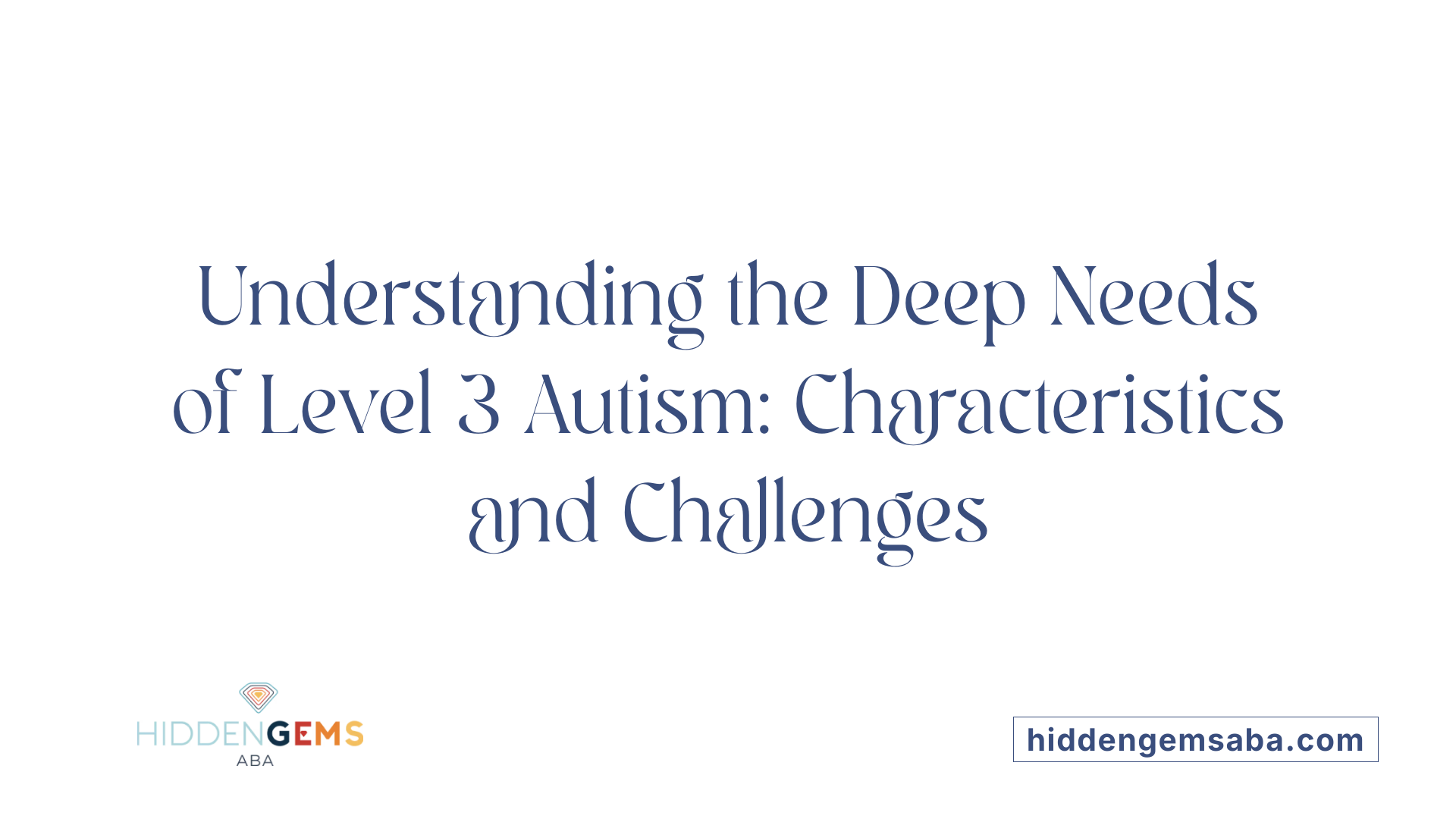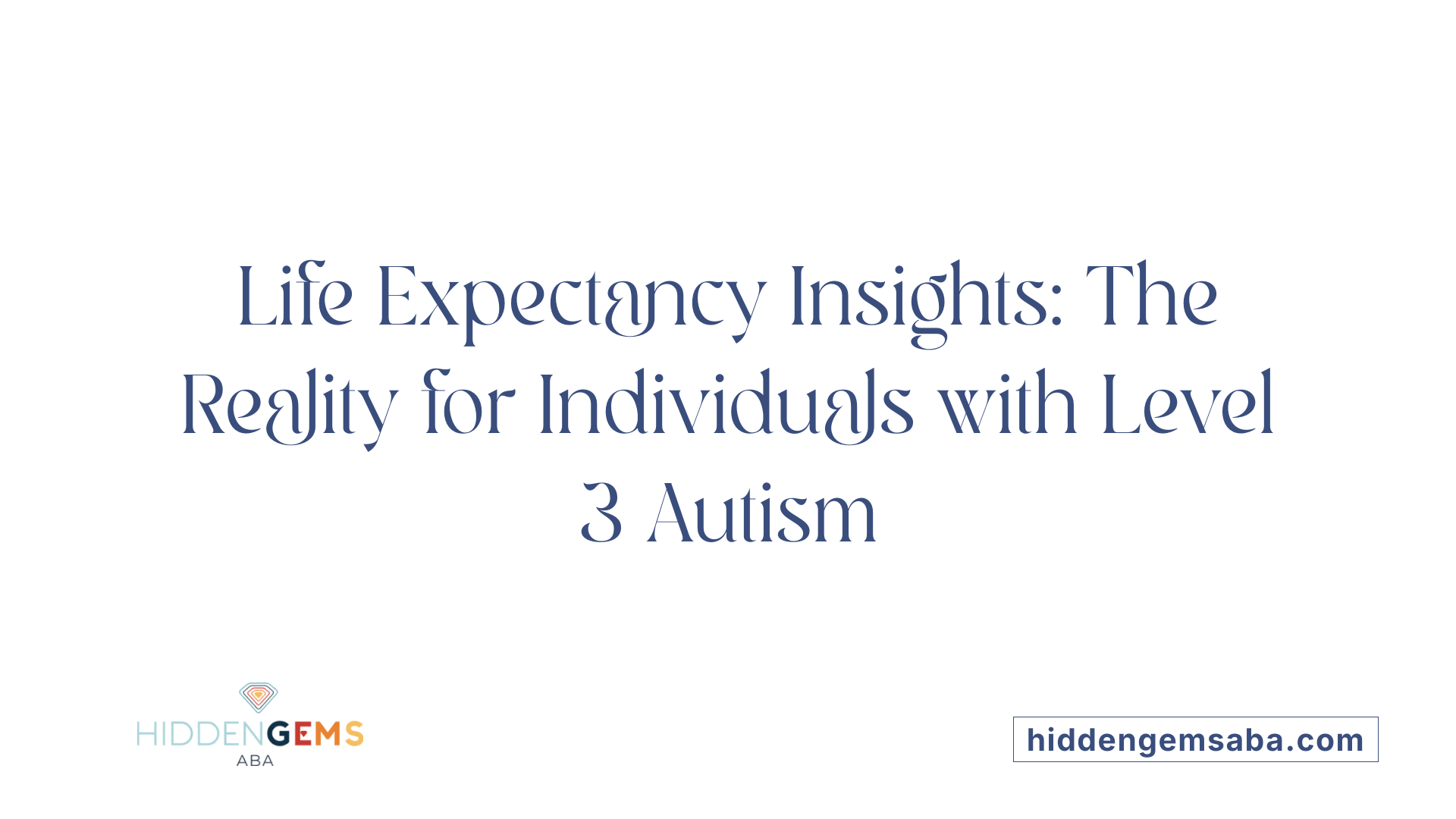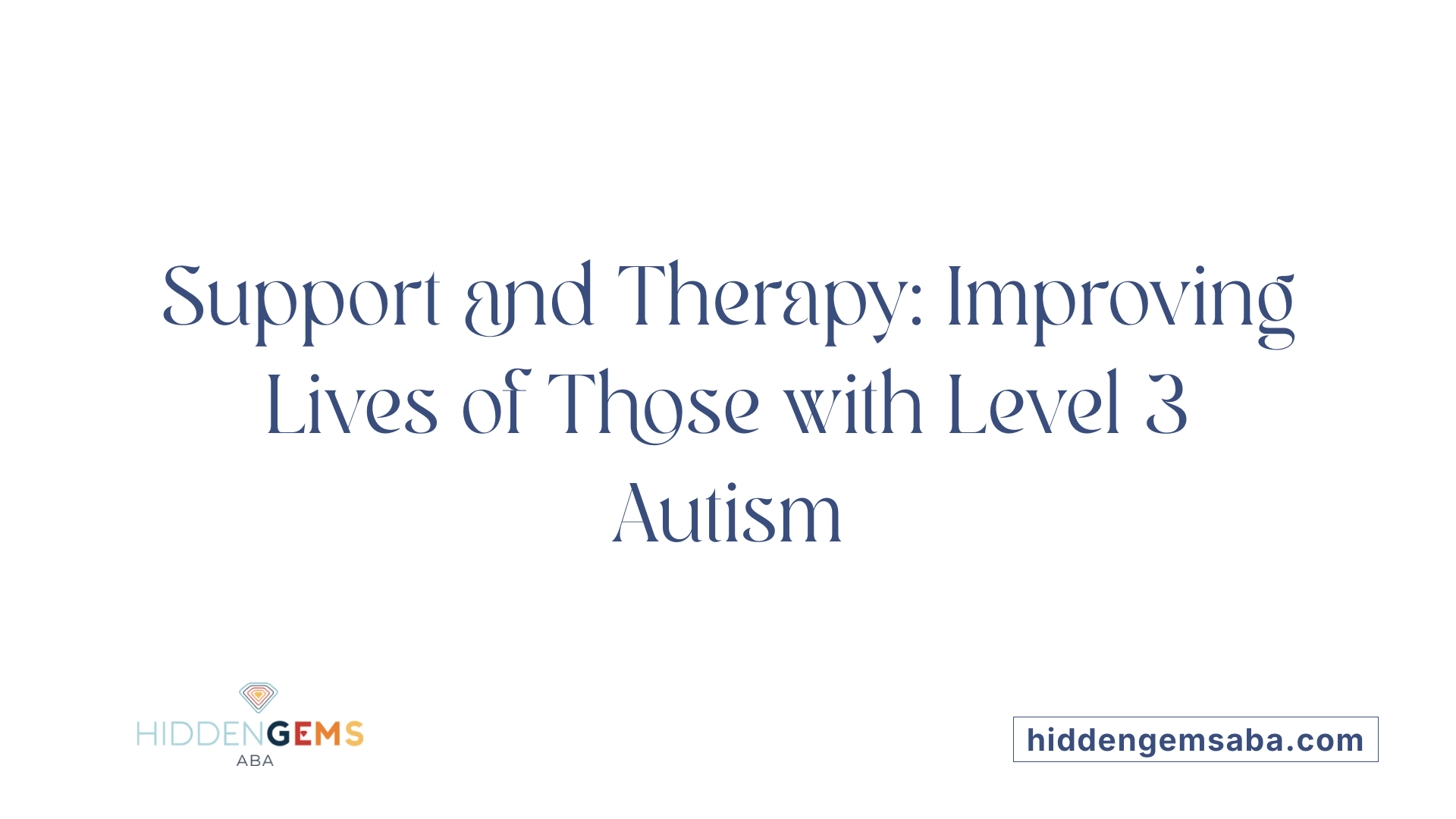Exploring Life Expectancy and Outcomes for Level 3 Autism
Level 3 autism, representing the most severe end of the autism spectrum, presents unique challenges and considerations. This article delves into the health, social, and long-term prospects for individuals with Level 3 autism, supported by research and expert insights. We examine factors affecting life expectancy, prognosis, and ways to improve quality of life, providing a comprehensive overview for caregivers, health professionals, and individuals alike.
Defining Level 3 Autism and Its Characteristics

What is Level 3 autism?
Level 3 autism refers to the most severe classification within the autism spectrum disorder (ASD) according to the DSM-5. This level is characterized by significant impairments in communication, social interaction, and behavior. Individuals at this stage often require around-the-clock support to manage daily activities and ensure safety.
Unlike some other forms of autism, Level 3 is generally associated with profound challenges that can include minimal or no verbal communication, reliance on gestures or alternative communication methods, and severe difficulties with mobility or self-care. Many individuals are also diagnosed with additional health conditions such as epilepsy or sensory processing disorders.
While Level 3 autism is not a formal diagnosis on its own—it's part of the severity levels used to classify the spectrum—the term is often used informally to describe individuals with profound needs.
Common symptoms and support needs
Individuals with Level 3 autism exhibit symptoms such as:
- Limited or absent verbal language
- Challenges initiating or responding to social interactions
- Repetitive behaviors and intense focus on specific topics or objects
- Difficulties with basic tasks like dressing or feeding
- Sensory sensitivities and difficulties managing environmental stimuli
Support needs are extensive and ongoing, including:
- Assistance with daily living activities
- Structured routines and visual cues to enhance understanding
- Therapies like ABA, speech therapy, and occupational therapy
- Medical interventions for co-occurring conditions, such as epilepsy
- Emotional and behavioral support to address self-injury or aggression
Difference between Level 3 autism and other autism levels
| Aspect | Level 1 | Level 2 | Level 3 |
|---|---|---|---|
| Communication | Some verbal, needs support | Limited speech, requires significant support | Minimal or no verbal skills, extensive support |
| Social Skills | Recognizes social cues, limited engagement | Limited social interactions, requires substantial support | Very limited social awareness, needs comprehensive support |
| Behavior | Repetitive behaviors, some flexibility | Repetitive with some challenges in flexibility | Rigid routines, severe behavioral challenges |
| Daily Support | Some independence | Needs help with daily activities | Entirely dependent on caregivers |
People with Level 3 autism face lifelong challenges affecting communication, behavior, and daily living. Advances in therapies and supportive environments can greatly improve quality of life, but many require ongoing comprehensive care.
Additional insights
Research indicates that early diagnosis and tailored interventions can enhance outcomes for individuals with severe autism. While no cure exists, therapies and support systems aim to improve independence and well-being.
Understanding the profound support needs and potential for growth helps foster more inclusive and effective care strategies for those at Level 3 of the autism spectrum.
Life Expectancy of Individuals with Severe Autism

What is known about the life expectancy of individuals with Level 3 autism?
Individuals classified as having Level 3 autism display severe support needs, often requiring round-the-clock assistance with daily activities such as dressing, feeding, and hygiene. They typically have minimal or no language skills, making communication challenging. Lifespan estimates suggest that individuals with Level 3 autism tend to have a much shorter life expectancy compared to the general population.
Research indicates that the average lifespan of those with severe autism is around 39 years. This means they can live up to approximately 40 years earlier than the average person, who typically lives into their late 70s or 80s.
Several factors influence this reduced lifespan. Co-occurring medical conditions such as epilepsy, which affects 20-40% of autistic individuals, play a significant role. Those with epilepsy often present differently and are more resistant to treatment, which increases health risks. Respiratory issues, feeding challenges, musculoskeletal problems, and sensory impairments also contribute. Furthermore, social isolation, limited healthcare access, and difficulties navigating medical systems can exacerbate health outcomes.
While early intervention and effective management of health issues can improve quality of life and potentially extend lifespan, it remains true that the overall outlook for individuals with Level 3 autism is markedly different than for their neurotypical peers.
How does this compare with the general population?
The general population’s typical life expectancy hovers around 78-82 years. In contrast, individuals with Level 3 autism often face a life expectancy of about 39 years, representing a reduction of roughly 40 years.
This discrepancy reflects the cumulative impact of medical, social, and support-related challenges faced by individuals with severe autism. In particular, high rates of co-occurring conditions like epilepsy and health disparities contribute to this gap.
Impact of co-occurring conditions
Co-occurring conditions significantly influence life expectancy for individuals with Level 3 autism. Epilepsy, which is present in up to 40% of autistic individuals, increases risks related to seizures, brain health, and injury.
Other health issues like respiratory infections, feeding difficulties, and musculoskeletal problems further diminish lifespan. Emotional and behavioral challenges associated with difficulty communicating can delay treatment or exacerbate health issues.
Improved management of these conditions through medical advances, tailored therapies, and support systems can help improve outcomes. Nonetheless, the overall prognosis remains less optimistic than for the general population.
| Aspect | Typical lifespan | Notes |
|---|---|---|
| General population | 78-82 years | Average across multiple countries |
| Level 3 autism | ~39 years | About 40 years earlier |
| Contributing factors | - | Chronic health conditions, limited access, social factors |
Understanding these differences highlights the importance of comprehensive healthcare, social support, and ongoing research in extending meaningful life expectancy for those with severe autism.
Factors Influencing Life Expectancy and Outcomes

What factors influence life expectancy in individuals with Level 3 autism?
Autism spectrum disorder encompasses a wide range of experiences and needs, with Level 3 autism being the most severe form. Individuals at this level often face significant challenges in communication, daily functioning, and social interactions, which can directly influence their health outcomes and longevity.
One of the most impactful factors is the presence of medical comorbidities. Many people with Level 3 autism also have health conditions such as epilepsy, heart disease, and neurological disorders. For instance, epilepsy affects 20-40% of autistic individuals and often presents differently in those with severe autism. These conditions can increase risks of complications, reduce quality of life, and shorten lifespan. Autistic individuals with severe co-occurring conditions like multiple impairments or complex neurological issues tend to have a lower life expectancy.
Access to healthcare is another critical factor. Early diagnosis, persistent medical care, and targeted interventions are essential in managing health issues effectively. Unfortunately, barriers such as sensory sensitivities, communication difficulties, and socioeconomic challenges often limit access to adequate healthcare services. When support is unavailable or insufficient, health risks escalate, potentially leading to earlier mortality.
Behavioral and mental health risks also significantly influence longevity. Many autistic individuals experience co-occurring mental health conditions such as anxiety, depression, and OCD. These conditions are linked to a higher risk of suicidal ideation or attempts. Studies suggest that up to 11% of suicide deaths in the UK may involve autistic individuals, highlighting the importance of mental health support.
Social and environmental factors cannot be overlooked. Social isolation, discrimination, poverty, unemployment, and adverse childhood experiences exacerbate health disparities among autistic populations. These social stressors can contribute to toxic stress, which adversely affects physical health and accelerates aging signs.
Individuals with Level 3 autism often require extensive support throughout life, including assistance with daily routines and health management. Their challenges in initiating or responding to social interactions, coupled with limited means of communication, can impede timely recognition and treatment of health issues.
In summary, life expectancy for individuals with Level 3 autism is shaped by a complex interplay of medical, behavioral, and social factors. Improving access to healthcare, providing comprehensive mental health support, and addressing social inequalities are vital steps in enhancing lifespan and overall well-being for these individuals.
Common Causes of Mortality in Level 3 Autism

What are the main causes of death for individuals with Level 3 autism?
Individuals with Level 3 autism often face increased health risks that can significantly affect their lifespan. The primary causes of death include injuries and poisoning, which can occur due to accidents or self-harm behaviors that individuals may struggle to communicate or prevent.
Nervous system disorders, particularly epilepsy, play a substantial role. Between 20-40% of autistic people experience epilepsy, and those with Level 3 autism tend to present differently, often with higher resistance to treatment. Unfortunately, this can lead to severe complications, and about half of autistic individuals with epilepsy and concurrent intellectual disability do not survive past their 40s.
Mental health issues also contribute to mortality risks. Autistic individuals are at a higher risk of attempting or dying by suicide. Studies suggest that up to 11% of suicide deaths in the UK could be among autistic individuals. Common co-occurring mental health conditions, such as depression, anxiety, and obsessive-compulsive disorder (OCD), further increase this danger.
Overall, the combination of physical health problems like epilepsy, mental health issues, and the increased potential for injury or poisoning significantly impacts life expectancy for those with Level 3 autism. Proactive medical management, mental health support, and safety measures are essential to improve outcomes.
Variations in Lifespan Based on Comorbidities and Support
How does overall health and support affect lifespan for Level 3 autism?
Individuals with Level 3 autism often face significant challenges in communication, social interaction, and daily functioning. These difficulties can be compounded by co-occurring health conditions, such as epilepsy, sensory processing issues, and physical impairments. The severity of these comorbidities plays a crucial role in determining lifespan.
Research suggests that early diagnosis and targeted interventions can improve daily skills and reduce health risks. For example, therapies like applied behavior analysis (ABA), speech and occupational therapy, and sensory integration help to develop skills and manage symptoms.
Compared to children with mild cerebral palsy, who have around a 99% chance of living to age 20, those with severe cerebral palsy—similar in severity to Level 3 autism—have a lower survival rate, with about a 40% chance to reach 20 years old. This illustrates how severity and associated health issues can affect longevity.
Proactive healthcare management, such as controlling epilepsy and preventing respiratory and feeding complications, can extend life. Support systems including specialized healthcare, social services, and family involvement are essential.
While profound intellectual disability often correlates with shorter lifespans in individuals with Level 3 autism, those with better health management and social support tend to experience improved outcomes. These combined efforts can delay or mitigate some of the health risks that typically reduce lifespan.
Therefore, a comprehensive approach focusing on health, early intervention, and societal support is vital for optimizing lifespan and quality of life for individuals with severe autism.
Insight into Support and Therapeutic Interventions

How can therapies improve the lives of individuals with Level 3 autism?
Therapies such as Applied Behavior Analysis (ABA), speech therapy, and occupational therapy play a crucial role in enhancing the skills and daily functioning of individuals with Level 3 autism. ABA, in particular, focuses on behavioral improvements, helping individuals develop better communication, social skills, and independence. Speech therapy supports individuals in improving their language abilities and alternative communication methods. Occupational therapy assists in developing essential life skills, such as dressing, feeding, and hygiene, while also addressing sensory processing challenges.
Why are structured routines and visual supports important?
For individuals with Level 3 autism, consistent routines and visual supports can significantly reduce anxiety and sensory overload. Structured daily schedules give predictability, helping individuals understand what to expect and thus easing transitions. Visual cues — such as picture schedules, timers, and social stories — foster understanding and independence, making it easier for individuals to engage with their environment and caregivers. These tools are tailored to individual needs, promoting clarity and reducing behaviors driven by distress or confusion.
How does community inclusion enhance well-being?
Promoting community participation and social inclusion is vital for enriching the lives of those with Level 3 autism. Participation in community activities, adapted social groups, and educational programs helps build social skills, reduces feelings of isolation, and enhances self-esteem. Inclusive environments that accommodate sensory and communication needs enable meaningful engagement, foster friendships, and support emotional development. Supporting families and caregivers with resources and education ensures continuous, consistent support at home and outside.
| Aspect | Benefits | Additional Details |
|---|---|---|
| Therapies (ABA, speech, occupational) | Improve communication, daily skills, and behavior | Tailored to individual needs, most effective when started early |
| Structured routines & visual supports | Reduce anxiety, promote independence | Include picture schedules, social stories |
| Community involvement | Strengthen social skills, reduce isolation | Adapted activities, inclusive settings |
Can the quality of life and life expectancy be improved?
Improving the overall quality of life and possibly the life expectancy of individuals with Level 3 autism involves a multidisciplinary approach. Early, intensive interventions like ABA and targeted therapies can help develop foundational skills and foster independence. Creating accessible environments, addressing sensory and behavioral challenges, and managing co-occurring health conditions are essential. Support systems that include caregivers and community resources are vital to ensuring consistent care and opportunities for social participation.
Building life skills, encouraging community inclusion, and providing ongoing health and behavioral support can improve both life satisfaction and longevity. While there is currently no cure for severe autism, comprehensive, personalized strategies significantly enhance the quality of life for individuals across their lifespan.
Importance of Societal and Policy Support
Need for societal inclusion
Autistic individuals, especially those with severe autism levels such as Level 3, face many daily challenges that extend beyond personal health. They often experience difficulties in communication, social interaction, and independence, which can lead to social isolation and marginalization. Societal inclusion involves creating environments where autistic people are valued, understood, and supported. This includes accessible public spaces, inclusive education, employment opportunities, and social activities tailored to diverse needs.
Policy initiatives for better healthcare access
Effective healthcare systems are crucial in improving the life expectancy and quality of life for autistic individuals. Policies must focus on expanding access to specialized medical care, mental health services, and therapies like ABA, speech, and occupational therapy. Early diagnosis and intervention are vital, particularly for children with severe autism, to manage symptoms and support development. Governments should allocate resources to training healthcare professionals about autism-specific needs, ensuring that treatments are equitable, culturally sensitive, and available across communities.
Supporting families and caregivers
Families and caregivers play a vital role in the well-being of individuals with severe autism. Support systems such as respite care, counseling, and financial assistance can alleviate caregiver stress and enable sustained care. Public awareness campaigns are also essential to educate society on autism and reduce stigma, fostering a more understanding environment. Strengthening community networks and advocacy groups can empower families, promote better living conditions, and ensure that autistic people receive the lifelong support they need to thrive in society.
| Topic | Key Points | Additional Details |
|---|---|---|
| Societal Inclusion | Environments, education, employment, social activities | Focus on accessibility and diversity |
| Healthcare Access | Specialized services, early intervention, policy support | Enhance training, resource allocation, equitable care |
| Supporting Families and Caregivers | Respite, counseling, financial aid, reducing stigma | Community programs, advocacy, caregiver well-being |
The Future of Research and Support for Level 3 Autism
Current research gaps
Despite advances in understanding autism, especially for those in moderate to severe ranges like Level 3, significant gaps remain. Many studies focus on observable traits or biological factors, but less attention is given to lived experiences of individuals with profound autism. More research is needed into effective support systems that enhance quality of life, such as tailored therapies, improved healthcare access, and social inclusion strategies. Additionally, understanding the long-term health challenges faced by Level 3 individuals, including comorbid conditions like epilepsy, remains limited.
Involving autistic voices
Involving autistic individuals in research partnership is vital. Their firsthand insights can shape priorities that matter most to them, from daily support needs to societal attitudes. Currently, many studies rely solely on caregiver or professional perspectives, which can overlook personal experiences. Encouraging autistic-led research initiatives, community involvement, and participatory methods will help develop more relevant and respectful interventions.
Focus on holistic societal approaches
A broader societal perspective is crucial for improving life expectancy and well-being for Level 3 autistic people. This includes addressing social inequalities like unemployment, poverty, and social stigma. Creating accessible healthcare, supportive housing, employment opportunities, and community integration are some ways to foster inclusion. Society must also focus on trauma-informed care and sensory-friendly environments to reduce stressors that negatively impact health. Emphasizing systemic change over solely biological explanations promises a more equitable future.
| Aspect | Current Status | Future Directions | Details |
|---|---|---|---|
| Research focus | Biological and behavioral traits | Lived experiences, long-term health outcomes | Greater involvement of autistic voices and personal stories |
| Support systems | Therapy-based, caregiver-led | Community-based, societal support initiatives | Enhancement of social inclusion, housing, employment programs |
| Policy and societal change | Awareness campaigns, basic accommodations | Systemic reforms to reduce inequalities | Addressing social determinants of health and well-being |
Focusing on these areas can lead to more effective, respectful, and inclusive support for individuals with Level 3 autism, ultimately improving their life expectancy and quality of life.
Enhancing Outcomes and Fostering Hope
While Level 3 autism presents considerable and lifelong challenges, ongoing advancements in medical care, therapies, and societal support are crucial to improving health outcomes, daily living, and overall life expectancy. Emphasizing early intervention, inclusive policies, and community understanding can foster more promising futures for individuals on the severe end of the autism spectrum, ensuring they live with dignity, support, and as much independence as possible.
References
- Chapter 3 – Parliament of Australia
- Autism does NOT reduce your life expectancy
- What 'High-Functioning' Autism Means
- Cerebral Palsy Life Expectancy - How Long Will My Child ...
- Understanding Severe Autism (Level 3) and Its Impact
- ASD levels of severity
- Long-term outcome of autism spectrum disorder - PMC






